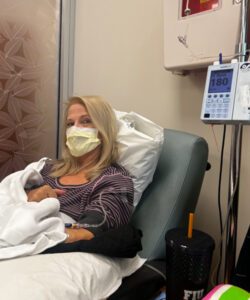
Thousands of people across the country are waiting for a new liver because of advanced liver disease. One of them was Meredith Stiehl, 57, of Fayetteville, who had become sicker and sicker over the past eight years.
Most of the time, people who need a liver transplant must wait for a deceased donor, and there aren’t enough livers to go around. Thankfully, there’s another option: a living-donor transplant, in which a patient’s diseased liver is removed and replaced with a portion of the liver from a healthy, living donor.
Meredith’s 26-year-old daughter, Kenan, raised her hand to be that donor. Tests showed the two were a match, and in March, surgeons performed the first liver transplant from a living donor at UNC Health in nearly 20 years.
“I feel honored that I was able to do it,” Kenan says. “I think it’s priceless to be able to help her and to have her for longer.”
Living-Donor Transplants Fill a Great Need
The liver is a critical organ that helps the body digest food, store nutrients and remove waste products from the blood. Several diseases can cause it to fail.
When patients have end-stage liver disease, they become very ill as they wait for a deceased-donor transplant. The national waiting list ranks recipients by the severity of their disease, and a new national policy has reduced the number of livers available in several states, including North Carolina.
“A variety of factors, including increasing burden of chronic liver disease and changes in organ allocation policy, have made it increasingly difficult for patients with a need for liver transplantation to receive a deceased-donor transplant from the waitlist,” says Oren Fix, MD, MSc, medical director of the liver transplant program.
Living-donor transplants circumvent that problem. During a living-donor transplant, the recipient’s diseased liver is removed and replaced with a portion of a healthy liver from the living donor. Over time, the newly transplanted portion grows to meet the body’s demand and slowly restores normal liver function in the recipient.
The remaining portion of the donor’s liver returns to its normal volume and capacity within a couple of months after the surgery.
Best of all, the recipient doesn’t have to get progressively sicker while waiting for a liver. A living-donor transplant can be scheduled at the best time for both recipient and donor.
“It is extremely satisfying to offer this treatment to our patient, who didn’t have to undergo prolonged suffering while waiting for a deceased-donor liver,” says Chirag Desai, MD, a UNC Health transplant and pancreatic surgeon and surgical director of the liver transplant program. He performed the Stiehls’ surgeries alongside Sorabh Kapoor, MD, a UNC Health abdominal transplant surgeon.
Now, UNC Health has expanded its transplant services to include living-donor transplants.
“We are so grateful to be the first,” Meredith says. “It feels like a miracle.”
Giving Mom the Gift of Life

Liver disease had taken a major toll on Meredith’s life. She frequently dealt with nausea, vomiting and fatigue, and she lost 80 pounds. She was so exhausted, she struggled to walk.
Still, she had hesitations about finding a living donor to help her. Then, Kenan surprised her with the news: She had taken the necessary tests and was a match.
“I was amazed,” Meredith says. “At that point, I was really ready to get my life back on track.”
The UNC Health transplant team gave mother and daughter a series of physical and psychological exams to determine their readiness for surgery.
“There are so many questions and sacrifices that come with the surgery,” Meredith says. “They really prepare you and make sure you understand the process.”
Kenan felt confident and supported by the transplant team too, she says. “I trust medicine. That’s why my automatic reaction was to volunteer for the surgery, aside from the love I have for my mom.”
Once, Kenan had what she describes as a “mental breakdown,” feeling overwhelmed by the process. She relied on her care team to get through it. “The nurses were just so solid,” she says. “They were my heroes.”
In certain liver diseases, living-donor transplants tend to be most successful when the donor and recipient are biologically related, Dr. Kapoor says.
“Living-donor transplant allows us to minimize the time that the donor organ stays outside the body before being reconnected,” he says. The transplanted tissues “are of the optimum quality because they are coming from the young, healthy donor.”
There are risks of bleeding, swelling and infection shortly after the procedure for the recipient and the donor, but no long-term complications associated with living-donor transplantation. The donor’s gallbladder is typically removed to access the liver, but this doesn’t affect digestion or quality of life.
Recovering from Transplant Surgery and Enjoying More Years Together
Meredith spent two weeks in the hospital after the transplant and is doing well.
“It’s been a dream so far,” she says. “I had pain in the beginning from my incision, but I’d say 95 percent of the discomfort is gone now. It’s so great to be able to socialize with friends and enjoy life again.”
Kenan has recovered and is starting her first job as an occupational therapist. She jokes about having to give up her favorite fatty, spicy snack, Flamin’ Hot Cheetos, because she doesn’t have a gallbladder anymore.
What she does have is a mom on the mend.
“It was so hard watching her be so sick,” Kenan says. “I did it for all the future moments and so that she would just feel better. I’m excited for her to live a better quality of life now.”
Learn about becoming a living liver donor at UNC Hospitals or call our donor coordinator at 984-974-7568. Learn more about transplant care at UNC Health.

